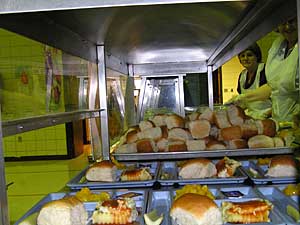|
Photos
|
 |
| Lunch trays filled with cheese lasagna, whole wheat roll, celery stick, can peaches lines up and ready to serve elementary kids. (MPR Photo/Cara Hetland) |
Sioux Falls, S.D. — If Joni Davis looks at her job in simple terms. It's very easy. She's in charge of setting the lunch menu for the Sioux Falls Public Schools.
"Knowing what kids like is not hard. You have a five day menu. It's tacos, french fries, hamburgers, hotdogs, chicken nuggets, french fries. That's really easy," says Davis.
What's hard is serving kids the things they're supposed to eat and that they like. Federal nutritional guidelines require ten servings of grain each week. There are also daily requirements for fruits and vegetables. Davis says the nutritional value of the whole meal must be no more than 30 percent calories from fat.
"Our program is set on a meal pattern. It's set on portions," says Davis. "So we have control on all of those things that are important to us all. What are the varieties and choices we're making and how much are we choosing. And so the issue or the challenge for school lunches has been just trying to move to the next level. Where you can still have hot dogs but can you find a low fat one."
In fact, low fat hotdogs have been on the menu for a few years. Davis is constantly testing new foods that will meet fiber and grain requirements.
"Can we purchase whole grain pastas? Can we find rice - brown rice? Even if you're baking yourself what kinds of things can you make that kids will enjoy when it looks brown," questions Davis.
Joni Davis wants the food service industry to help by creating meals that are low in fat and high in fiber. Some pizzas are offered with low-fat cheese, whole grain crusts and turkey pepperoni.
Davis is part of South Dakota's statewide wellness coalition. The group recommends healthier eating and daily physical activities for kids. In fact, the No Child Left Behind law that includes federally mandated standards for academics also applies to nutrition. David says she wants to make sure kids have healthy food choices so they can excel in school.
But just because it's on their tray doesn't mean they'll actually eat it.
Dee Gulson, Oscar Howe Elementary School Principal, has noticed more food is being thrown away in the cafeteria. She says when kids don't like the hot lunch, they bring something from home.
"We have seen more cold lunches," says Gulson. "I think perhaps maybe the children look at something and say, 'Well, that doesn't look like what my mom makes,' or 'I don't know what that is.'"
Gulson worries a lot of kids don't like the food and are going hungry. A quarter of the kids at Oscar Howe receive free or reduced lunch which means they may not be eating their only meal of the day. Dee Gulson fears they are being left behind.
Second grader Kira Wagner looks at her lunch tray. Cheese lasagna, whole wheat roll, can peaches, celery stick and milk. She's determined not to eat it.
"I'm not gonna (eat it) they served it for me for lunch," says Wagner. "I didn't know what they were going to have because I didn't look at the schedule," she says.
Even before they try it, a lot of kids say they don't like the cheese lasagna. Cold lunch bags outnumber hot lunch trays on some tables.
But, Kira Wagner tasted her lasagna after all. She's not wild about lasagna at home so she figured she'd give it a chance at school because it looks different.
"Well, this isn't the kind my mom makes at home so I wanted to try it here at lunch," says Wagner.
For these kids, school lunch isn't about fat content and fiber, it's about having the energy to finish the school day. For nutritionists it's about education. Teaching kids how to make healthy choices. School officials say they'll start putting nutritional information on the monthly menu so parents can also learn about the changes to the lunch menu.






